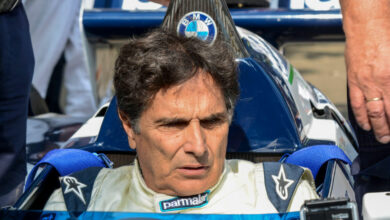F1 News: Red Bull’s Game-Changing Rear Wing at Singapore GP
Red Bull Racing’s introduction of a new, innovative rear wing design for the Singapore Grand Prix marked a significant development in the F1 2024 season. This novel concept, inspired by rival teams, is poised to alter the dynamics of car performance, showcasing Red Bull’s commitment to technological advancements and competitive edge.
Key Takeaways:
- Innovative Design: Red Bull has unveiled a semi-detached wing tip section for the RB19 at the Singapore GP, a move aimed at optimizing drag and downforce in line with the unique demands of the circuit. This design includes a lateral extension of the upper flap, affecting vortex formation and the wing’s aerodynamics.
- Inspiration from Competitors: The new design openly draws inspiration from competitors, with a unique curl to the endplate for improved local load. This approach, detailed in the FIA technical submission documents, highlights Red Bull’s adaptive strategy in a fiercely competitive field.
- Rival Teams’ Responses: Other teams like Alpine, AlphaTauri, and McLaren have also introduced new rear wings, with some, including Aston Martin and Alpine, opting for an alternate design that eschews the traditional metal bracket for a more liberal aerodynamic approach.

The F1 world witnessed a significant strategic shift as Red Bull Racing debuted its latest aerodynamic innovation at the Singapore Grand Prix. The RB19’s rear wing now features a semi-detached wing tip section, an engineering marvel aimed at optimizing the car’s performance to suit the challenging Singapore circuit. This update is not just a minor tweak but a radical overhaul of the wing’s tip and rear cutout shape, demonstrating Red Bull’s relentless pursuit of excellence in aerodynamics.
Furthermore, Red Bull’s transparency about its inspiration sources is refreshing in the typically secretive world of F1 engineering. Their official statement in the FIA technical documents acknowledges the influence of competitor designs on their new rear wing, stating, “Taking inspiration from competitor designs, the end of the flap element has a revised curl to the endplate which offers more local load for this element for this particular upper wing design.” This candid admission highlights the iterative nature of innovation in F1, where teams continuously learn from and adapt to each other’s advancements.
This development wave has rippled across the paddock, with teams like Alpine, AlphaTauri, and McLaren also introducing new rear wings. Additionally, an alternative design, initially brought to the limelight by Aston Martin and Alpine at the Monaco Grand Prix, presents a different approach to connecting the upper tip section and the endplate, eschewing the traditional metal bracket. This design was quickly adopted by powerhouses Mercedes and Ferrari, signifying its perceived potential.
Aside from the rear wing, Red Bull hasn’t shied away from further innovations. They’ve implemented modifications to the floor edge of the RB19, increasing camber in the forward portion for enhanced aerodynamic performance. Elaborating on this, Red Bull explained, “To exploit energy in the air stream, more camber has been applied to the forward part of the floor edge wing resulting in more local load from this region of the floor assembly.”
As the F1 season progresses, it’s clear that the battle for technological supremacy is as fierce as the competition on the track. Red Bull’s latest aerodynamic enhancements underscore their commitment to staying at the forefront of innovation, continually pushing the boundaries of what’s possible in the high-octane world of Formula 1 racing.




